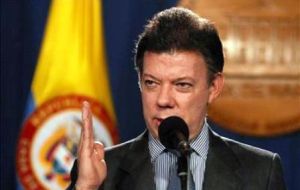MercoPress. South Atlantic News Agency
Unasur Finance ministers meet in Peru to address the glut of US dollars
 Colombian president Juan Manuel Santos proposed the meeting
Colombian president Juan Manuel Santos proposed the meeting Unasur Finance ministers struggling to stop economic harm from several years of US dollar decline will seek to agree on a coordinated response when they meet Friday in Lima.
The meeting comes as Latin America is bracing for another surge in foreign investment inflows, which have quadrupled since 2003, amid concern that recoveries in the US and Europe are faltering and may force the Federal Reserve to begin another round of asset purchases as was decided Thursday by the European central bank in support of EU banks.
Union of South American Nations policy makers are concerned an average 25% rally in Latin American currencies since the end of 2008 is making its exports less competitive and hurting manufacturers by spurring a surge in cheaper imports.
“We’re going to discuss common defence strategies for our markets in relation to an invasion from other countries” Brazilian Finance Minister Guido Mantega told reporters in Brasilia before departing for Lima. “It’s a very important Latin American agenda in a moment when the global crisis is deepening.”
Finance ministers in Chile, Peru and Colombia, who haven’t gone as far as Mantega in restricting foreign investment, may change if capital controls like Brazil’s taxing of foreigners’ buying of bonds can be applied in a joint way that won’t frighten investors, said Mauricio Cardenas, a former Colombian development minister.
“A coordinated effort helps reduce the risk to nations’ reputation among investors while increasing the effectiveness of controls,” said Cardenas, who is the director of the Latin America program at the Brookings Institution in Washington.
“Colombia, Peru and Chile have been reluctant to go in the direction of Brazil, but they have been watching and if they see these measures are effective they could follow suit.”
Friday’s meeting of Finance chiefs from the 12-nation Unasur was first proposed at the urging of Colombian President Juan Manuel Santos. On July 28, Santos also said that Latin America can’t be a “mere spectator” as the value of the region’s record 700 billion in reserves is eroded by the decline of the dollar and the Euro.
“The appreciation of the majority of our currencies is destroying our capacity to generate jobs,” said Santos in the statement. “We are being very negatively affected.”
However developing nations aren’t alone in fighting the dollar’s decline. Japan on Thursday injected 10 trillion yen (126 billion dollars) to stem an appreciating exchange rate, a day after Switzerland unexpectedly cut interest rates and pledged to boost the supply of the franc.
Mantega, who has accused the U.S., Japan and Europe of sparking a global “currency war” through the use of near-zero interest rates, will attend the meeting along with finance ministers from the rest of South America. Mexico’s finance ministry, which was also invited, declined to comment when asked whether it was sending any officials.
Investors are flocking to Latin America after the region grew at its fastest pace in 30 years last year. The World Bank estimates that net private inflows surged to 203.4 billion last year as the region expanded 6% amid strong demand from China for Chile’s copper, Brazil’s iron ore and Argentina’s soy. In 2003, inflows totalled 57.5 billion dollars, the Washington-based lender said.
In Brazil, the region’s biggest economy, foreign direct investment hasn’t let up this year, jumping to a record 69 billion in the 12 months through June.
To ease pressure on the Super Real that has appreciated 47% since the end of 2008, Brazil has tripled a tax on bond purchases by foreigners and raised levies on borrowing abroad. Last week, Mantega slapped a tax on bets against the dollar in the futures market.
The Super Real rally is taking its toll on manufacturers, who are losing ground to Chinese imports even as domestic demand remains robust in the wake of the fastest economic growth last year in two decades. Industrial output fell 1.6% in June. The Sao Paulo Industrial Federation estimates that the country’s trade gap in manufactured goods will widen to 100 billion dollars this year from 71 billion in 2010.
While Chile and Colombia have stepped up daily purchases of dollars this year, and Peru did the same last year before presidential elections cut demand for the Sol, none has acted as aggressively as Brazil to stem inflows.
That’s in part because Brazil’s 5.79% real interest rate, the second-highest after Croatia is a magnet for investors seeking higher yields.
“Brazil stands out in being more active but not as being more effective” in fighting currency gains, said Alberto Ramos, an economist at Goldman Sachs Group Inc. in New York. “Chile and Mexico have been much less activie and they have fared much better.”
Chile in March slashed spending by 750 million dollars, equal to 0.4% of GDP, to take pressure off the Peso, which has rallied 16% since the central bank began raising interest rates in June 2010. Policy makers in January also announced they’d purchase a record 12 billion dollars this year, equal to 43% of currency reserves.
In Colombia, where the peso has gained 14 percent against the dollar since the end of 2009, the central bank is buying at least 20 million dollars a day in the spot market. Peru purchased 9 billion last year, the second-biggest amount ever, and increased reserve requirements to lift the cost of short-term, overseas borrowing.




Top Comments
Disclaimer & comment rulesCommenting for this story is now closed.
If you have a Facebook account, become a fan and comment on our Facebook Page!